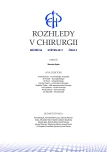Thoracoscopic, epicardial ablation of atrial fibrillation using the COBRA Fusion system as the first part of hybrid ablation
Authors:
P. Budera 1; P. Osmančík 2; D. Talavera 1; R. Fojt 1; A. Kraupnerová 1; J. Žďárská 2; T. Vaněk 1; Z. Straka 1
Authors‘ workplace:
Kardiocentrum, Kardiochirurgická klinika, 3. lékařská fakulta Univerzity Karlovy a FN Královské Vinohrady, Praha
přednosta: prof. MUDr. Z. Straka, CSc.
1; Kardiocentrum, III. interní-kardiologická klinika, 3. lékařská fakulta Univerzity Karlovy a FN Královské Vinohrady, Praha
přednosta: prof. MUDr. P. Widimský, DrSc., FESC., FACC.
2
Published in:
Rozhl. Chir., 2017, roč. 96, č. 5, s. 203-208.
Category:
Original articles
Overview
Introduction:
Treatment of persistent and long-standing persistent atrial fibrillation is not successfully managed by methods of catheter ablation or pharmacotherapy. Hybrid ablation (i.e. combination of minimally invasive surgical ablation, followed by electrophysiological assessment and subsequent endocardial catheter ablation to complete the entire intended procedure) presents an ever more used and very promising treatment method.
Method:
Patients underwent thoracoscopic ablation of pulmonary veins and posterior wall of the left atrium (the box-lesion) with use of the COBRA Fusion catheter; thoracoscopic occlusion of the left atrial appendage using the AtriClip system was also done in later patients. After 2−3 months, electrophysiological assessment and catheter ablation followed. In this article we summarize a strategy of the surgical part of the hybrid procedure performed in our centre. We describe the surgery itself (including possible periprocedural complications) and we also present our short-term results, especially with respect to subsequent electrophysiological findings.
Results:
Data of the first 51 patients were analyzed. The first 25 patients underwent unilateral ablation; the mean time of surgery was 102 min. Subsequent 26 patients underwent the bilateral procedure with the mean surgery time of 160 min. Serious complications included 1 stroke, 1 phrenic nerve palsy and 2 surgical re-explorations for bleeding. After 1 month, 65% of patients showed sinus rhythm. The box-lesion was found complete during electrophysiological assessment in 38% of patients and after catheter ablation, 96% of patients were discharged in sinus rhythm.
Conclusion:
The surgical part of the hybrid procedure with use of the minimally invasive approach and the COBRA Fusion catheter is a well-feasible method with a low number of periprocedural complications. For electrophysiologists, it provides a very good basis for successful completion of the hybrid ablation.
Key words:
atrial fibrillation − hybrid ablation – thoracoscopy − catheter ablation − electrophysiology assessment
Sources
1. Camm AJ, Lip GY, De Caterina R, et al. 2012 focused update of the ESC Guidelines for the management of atrial fibrillation: an update of the 2010 ESC Guidelines for the management of atrial fibrillation. Developed with the special contribution of the European Heart Rhythm Association. Eur Heart J 2012;33:2719−47.
2. Chugh SS, Blackshear JL, Shen WK, et al. Epidemiology and natural history of atrial fibrillation: clinical implications. J Am Coll Cardiol 2001;37:371−8.
3. Ganesan AN, Shipp NJ, Brooks AG, et al. Long-term outcomes of catheter ablation of atrial fibrillation: a systematic review and meta-analysis. J Am Heart Assoc. 2013;18,2:e004549.
4. Cox JL, Schuessler RB, Lappas DG, et al. An 8 1/2-year clinical experience with surgery for atrial fibrillation. Ann Surg 1996;224:267−73;discussion 273−5.
5. Stulak JM, Suri RM, Burkhart HM, et al. Surgical ablation for atrial fibrillation for two decades: are the results of new techniques equivalent to the Cox maze III procedure? J Thorac Cardiovasc Surg 2014;147:1478−86.
6. Mack MJ. Current results of minimally invasive surgical ablation for isolated atrial fibrillation. Heart Rhythm. 2009;6,Suppl:S46−9.
7. Gelsomino S, Van Breugel HN, Pison L, et al. Hybrid thoracoscopic and transvenous catheter ablation of atrial fibrillation. Eur J Cardiothorac Surg 2014;45:401−7.
8. Calkins H, Kuck KH, Cappato R, et al. 2012 HRS/EHRA/ECAS expert consensus statement on catheter and surgical ablation of atrial fibrillation: recommendations for patient selection, procedural techniques, patient management and follow-up, definitions, endpoints, and research trial design. Europace 2012;14:528−606.
9. Budera P, Osmancik P, Herman D, et al. Risk of intraatrial thrombi after thoracoscopic ablation in absence of heparin and appendage closure. Ann Thorac Surg 2017; in press.
10. Osmancik P, Budera P, Zdarska J, et al. Electrophysiological findings after surgical thoracoscopic atrial fibrillation ablation. Heart Rhythm 2016;13:1246−52.
11. Rostock T, Salukhe TV, Steven D, et al. Long-term single- and multiple-procedure outcome and predictors of success after catheter ablation for persistent atrial fibrillation. Heart Rhythm 2011;8:1391–7.
12. Vroomen M, Pison L. Hybrid ablation for atrial fibrillation: a systematic review. J Interv Card Electrophysiol 2016;47:265−74.
13. Bulava A, Mokracek A, Hanis J, et al. Sequential hybrid procedure for persistent atrial fibrillation. J Am Heart Assoc 2015;25,4:e001754.
Labels
Surgery Orthopaedics Trauma surgeryArticle was published in
Perspectives in Surgery

2017 Issue 5
Most read in this issue
- Current possibilities to influence surgical site infection
- Autologous cranioplasty with a bone flap preserved subcutaneously in the mesogastrium
- Malignant fibrous histiocytoma as a rare cause of acute limb ischemia
- Thoracoscopic, epicardial ablation of atrial fibrillation using the COBRA Fusion system as the first part of hybrid ablation
